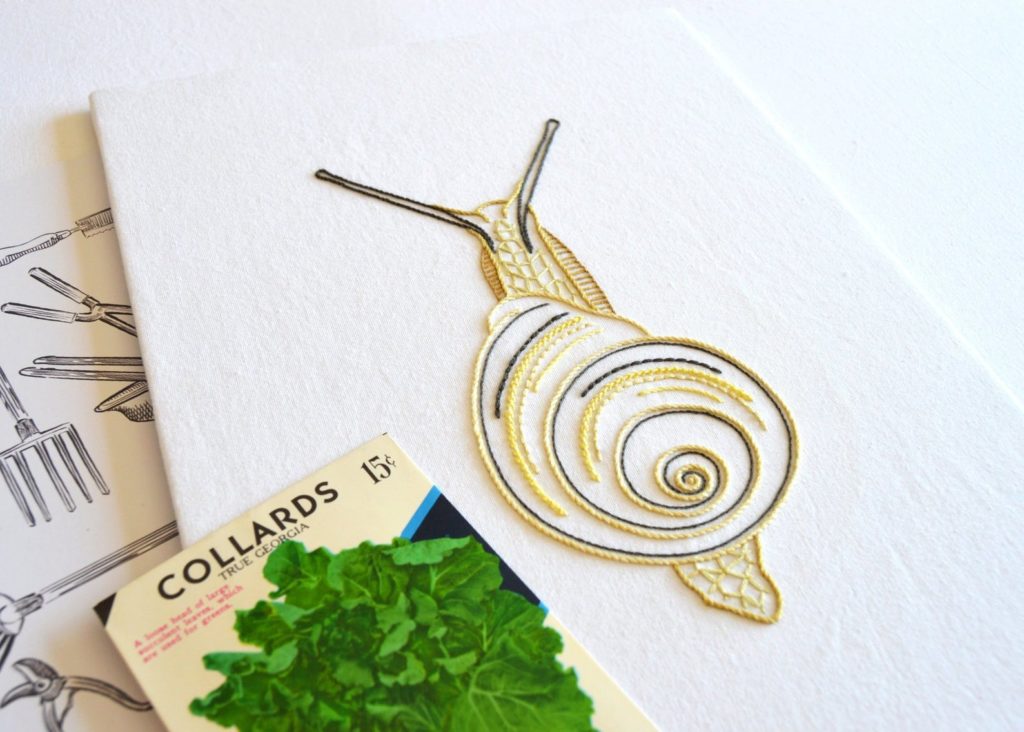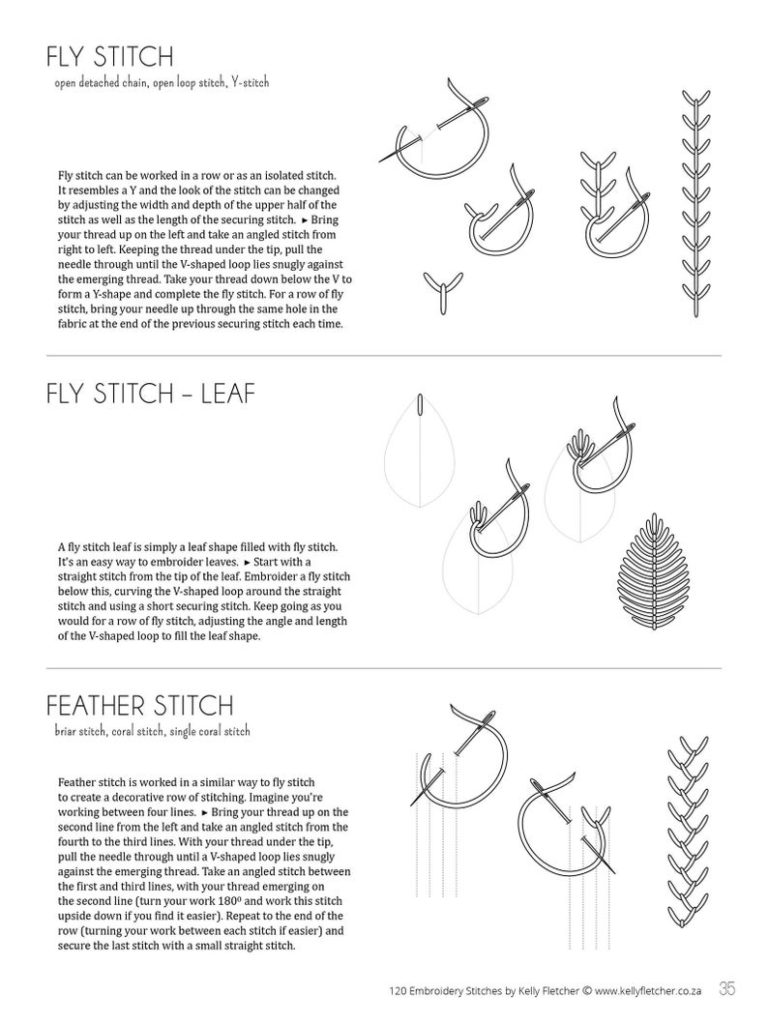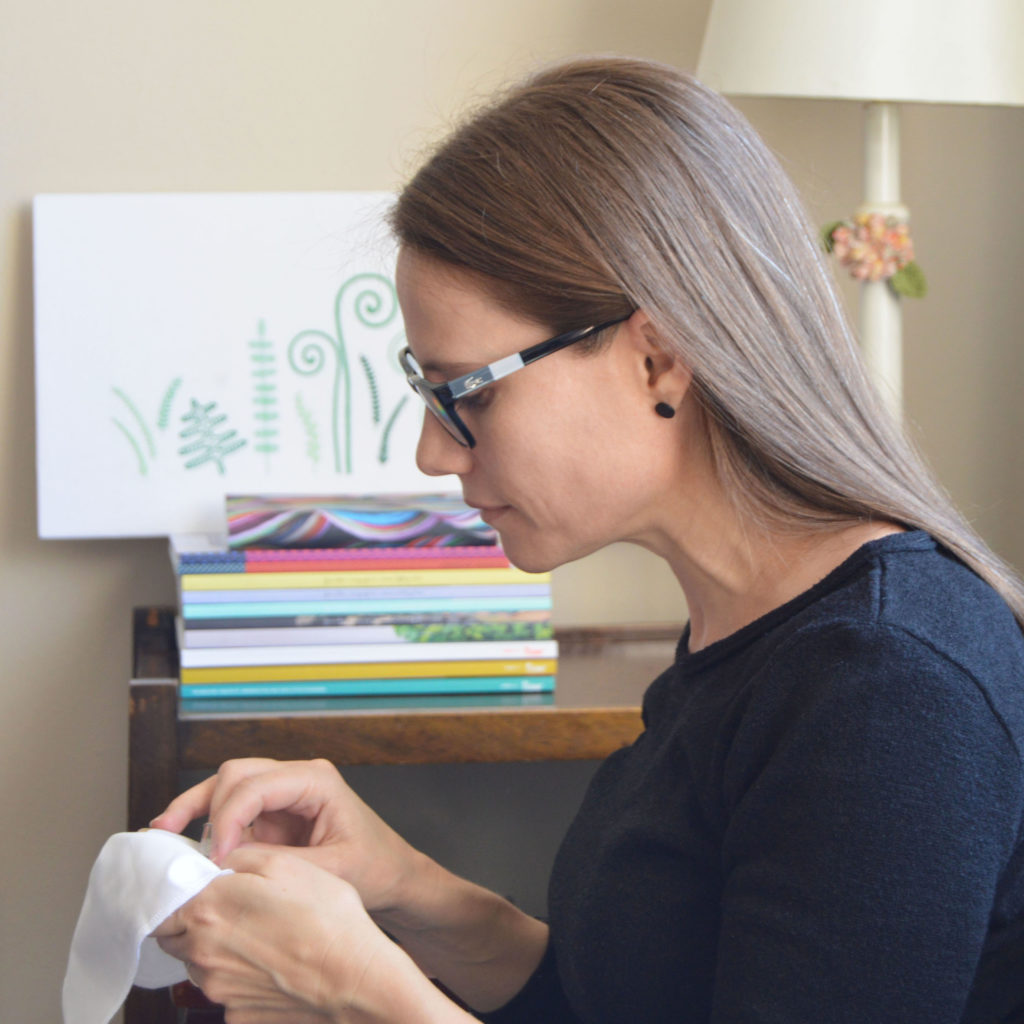Kelly Fletcher is a talented artist based in South Africa who literally wrote the book on embroidery. She’s known for using many different stitches in each design, and for her anatomical patterns of animals that don’t normally get a lot of attention, like lobsters, snails, and insects. Kelly is the author of Embroidered Home, 120 Embroidery Stitches, Embroidery Tips, Tricks & Techniques and Embroidery for Everyone (out 19 October 2021). You can find many of her patterns and books here, and more information at kfneedleworkdesign.com. Kelly and Maydel founder Lauren Venell had a chat about Kelly’s practice in July of 2021.
How and when did you get started with embroidery? What has kept it interesting for you over the years?
My first stitch book was a gift and it has the message “Happy stitching for years to come, 2004” written in it. But I grew up around three generations of women who created with fabric, needles, yarn and thread, although it was my mom who first got into hand embroidery. So any form of stitching feels natural to me.
The patterns available when I started embroidering were quite traditional, so I soon began coming up with my own ideas. My early designs were overly ambitious, but a good learning curve, and I was using lots of the stitches from that stitch book. I quickly became intrigued with how different stitches could be used to build and fill a design, rather than simply embroidering over lines, and my style developed organically from there.

I set up my first online shop in 2009, using the skills I’d picked up working in advertising, media and publishing to create PDF patterns and offer others like me something more contemporary to stitch.
There’s always another idea, whether a design or a way to use a particular stitch, to keep things interesting on the embroidery side. And the way technology is evolving and an industry developing around hand embroidery keeps it interesting on the business side. And then I’ve had so many amazing opportunities around the world that I’d never have experienced were it not for embroidery. I’ve authored books, created kits, been featured here and there, contributed to magazines and other people’s books, created a magazine supplement, partnered with a store in Chicago…
Ha! Yes, and we’re so glad you did!
You regularly use more different stitches in your embroidery than any other artist I know. You’ve detailed 120 of them in your wonderful book. How many have you collected now, and what are some of your favorites?
More than 120? I’ve used a few already that aren’t in 120 Embroidery Stitches – fly stitch filling, for example – and will probably need to start thinking about a follow-up at some point.
I definitely have favourites. And some stitches work better than others to give me the look I’m after. Stem stitch is my go-to for outlines, it’s so crisp and precise. Palestrina has a beautiful rhythm to it and so much texture. Fly stitch and broken chain stitch are just fun to do. And I love the look of cable chain stitch, even though it takes a bit of practice and concentration to get it right. I’m not a huge fan of knots. I’ve got them figured out by now, but still find them quite fiddly. At the moment I’m enjoying satin stitch, which wasn’t always the case.
As a casual science nerd, I’m obsessed with your anatomical embroidery designs. They’re like illustration plates from old field guides, but with the colors and textures of the different stitches bringing them even more to life. What made you want to use embroidery to create accurate representations of nature and how do you decide which organism to study next?
It happened quite naturally. A book proposal for the Frankfurt book fair fell through and I realised I had to make a change as editorial work was time-consuming and uncertain, and I needed a bread-and-butter option. So I sketched and designed as many different ideas as I could – keeping the designs smaller so people could embroider them in a weekend, but still incorporating lots of interesting stitches – to launch my online pattern store on Etsy.
Three of these designs were Anatomical Bee, Anatomical Beetle and Anatomical Dragonfly and I looked at loads of photos to help me visualise things like wings and feet in embroidery stitches. I didn’t want the insects to look cute (I also love natural history illustrations) and so the anatomical style emerged.

I’ve had a request from a pattern buyer for a scorpion… And I’m slowly working on an Anatomical Birds range. It really comes down to if I can visualise the creature in stitches – feather stitch for wing membranes, Ghiordes knots for furry thoraxes, bullion knots for femurs and tibias – and if it’ll be interesting and engaging to embroider.
I personally cannot WAIT for the birds. They’re my favorites!
I know that choosing a favorite design can be like choosing a favorite child, but are there any pieces you’d like to call out? Any that were particularly challenging to figure out, or particularly satisfying in their process or results?
My latest design is usually my favourite but looking back, I do prefer some over others, especially as I’ve got better at conceptualising and designing. The Wild ranges are particularly gratifying as I can take creative licence with them and they lend themselves to lots of interesting stitches. Being a reader, I really enjoy working on lettering and monograms. The detail and originality of the Anatomical designs is hugely appealing. And the mini hoops and holiday designs are always fun and uplifting to work on.
It always feels good when a stitch or design idea works straight off the bat. Using all-over stitch to create an entire piece of coral was a satisfying moment and using a single strand of thread for the membranes on the wasp wings opened up a whole new avenue of thought on stem stitch.

Where do you do your drawing and stitching? Do you have any favorite tips or tools you’d like to share?
I embroider mostly on the couch in front of the window where there is good natural light, usually listening to a podcast. I only get to sit and do this for a few hours once or twice a week, so it feels indulgent and is something I really look forward to.
My designs start as either rough sketches or a collection of reference photographs. I move between design software and a pencil, putting the “bones” in place and then sketching in the details, imagining it all in stitches as I go. This step generates a lot of eraser dust. So I move between my computer desk and work or dining table for this.
Most stitchers begrudge the next step: tracing on. So my tip is to befriend the process. Invest in the best tools for the job and take your time. Listen to a podcast or your favourite album. View it as a form of meditation. Your finished embroidery will turn out so much better for it.
What’s next for you and KF Needlework Design? What would you like to have more of (or less of) in your life and art practice?
I’d like to incorporate more fabric into my designs. There are stitches and ways of using them that seem made for the raw edges of embroidered appliqué, for example, but I’ve not really seen them used in this way.
And there could always be more time for personal work, to explore ideas and stitch simply for the joy of stitching.
Anything else you want people to know?
The act of sitting and embroidering has brought me so much pleasure and so many benefits that if I can encourage even one person to pick up a needle and thread through a good design, my work is done. Anyone and everyone can do hand embroidery, and it could change your life.


Maydel Comment Policy
All comments are moderated before they are posted. Irrelevant, offensive, or otherwise unhelpful comments will be removed.